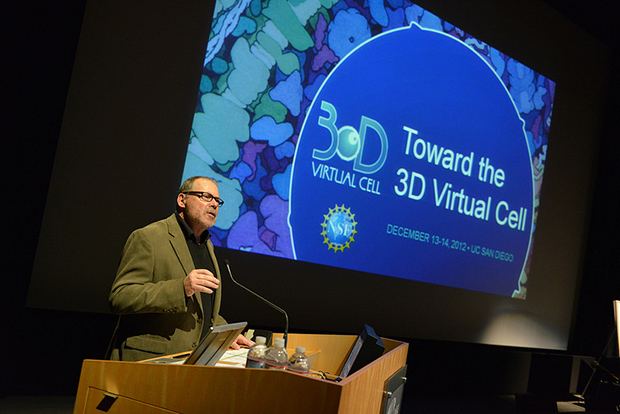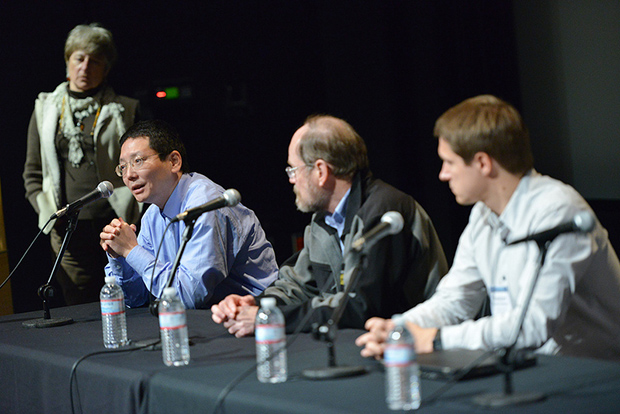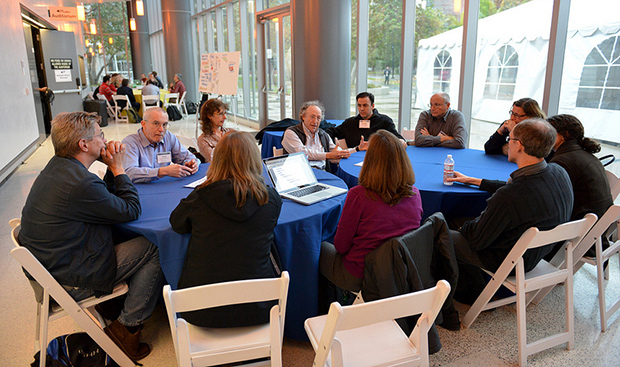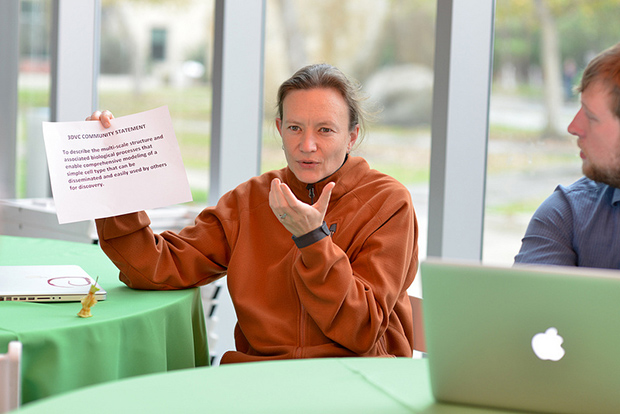Community Embraces Effort to Build 3D Virtual Cell
December Conference Highlights Potential for Cloud-based Collaborative Research
By:
- Doug Ramsey
Published Date
By:
- Doug Ramsey
Share This:
Article Content

Chair Phil Bourne addresses the opening session of the international "Toward the 3D Virtual Cell" conference at UC San Diego.
Scientists from the University of California, San Diego, national and international research centers launched a first-of-its-kind workshop series intended to bring together investigators from a wide range of scientific fields to develop a 3D Virtual Cell. Funding for the Dec. 13-14 conference was provided by the National Science Foundation (NSF).
Project organizers plan to use the workshops as a springboard for determining how the 3D Virtual Cell could become part of the NSF’s Software Infrastructure for Sustained Innovation (S2I2) program, which focuses on the establishment of long-term hubs of excellence in software infrastructure and technologies that will serve a research community of substantial size and disciplinary breadth.
“The 3D Virtual Cell represents a new place to go for scholarship that is broader than what we as scientists are accustomed to,” said UC San Diego professor of pharmacology Philip Bourne, who leads the university’s effort and chaired the “Toward a 3D Virtual Cell” conference. “A major goal of this event is to ask researchers from across the scientific community what needs and resources they think will drive the study of molecular and cellular biology in the coming years. We expect that the 3D Virtual Cell will play a major role in that discussion going forward.”

Panel discussions followed a series of short presentations on select topics.
Attendees and speakers from UC San Diego and the Torrey Pines Mesa research community—including the Sanford-Burnham Medical Research Institute, The Scripps Research Institute, and Salk Institute—joined researchers from industry, academia, federal agencies and international institutions from Germany, the United Kingdom and other countries . Hosted by the California Institute for Telecommunications and Information Technology (Calit2) on the UC San Diego campus, the December conference was the first in a year-long series of workshops aimed at promoting collaboration among biologists and technologists with the ultimate goal of crafting a computer-simulated cell.
As noted at the conference, the cloud-based 3D Virtual Cell is intended to serve as a “go-to” place for creating and sharing data capable of structurally describing very simple cells. Early project functionality is likely to include an online portal linking various cell biology associations and related collaborative groups, with an emphasis on expanding upon existing data about the design and biological processes of cells.
Future undertakings are expected to include the development of software aimed at shaping the research environment, in which the 3D Virtual Cell would exist as an open access-type central repository of molecular and cellular biology data. A key characteristic of this model is that it would be reciprocal in nature, with members of the scientific community not only accessing data from the repository, but also contributing sharable simulations and methodologies. Multiple conference attendees and speakers remarked that a 3D Virtual Cell resource based on this model could serve as a sort of “app store” similar to the ones used by Apple and Android for the distribution of online content and applications.

One of the working groups that focused the discussion on topics including infrastructure, sociology and education.
“With the 3D Virtual Cell, researchers will be able to run simulations of different types of biological processes, from simple enzymatic processes to complete biological pathways,” said UC San Diego’s Bourne. In turn, the data generated by such simulations is expected to provide new insight into how such processes and pathways function together—findings that could benefit students, basic scientists, and clinicians involved in the study of such diverse fields as tumor angiogenesis, neuroscience, bioinformatics, and genomics, all of which were represented at the December conference.
This preliminary model of the 3D Virtual Cell was discussed in-depth by approximately 150 conference attendees, including nearly 50 presenters. Speakers presented brief, TED-style talks followed by panel discussions on such diverse topics as whole-cell modeling, visualization, cellular behavior, and educational outreach. Additional activities included workgroup sessions devoted to outlining project goals, promoting interdisciplinary use of the 3D Virtual Cell, and negotiating a “middle ground” between the use of physical and virtual cell models.
Conference organizers made a special effort to elicit input from those in attendance. Participants were asked to shout out topics or questions they would like to address in breakout sessions, and this “open spaces” model resulted in more than 50 suggestions that were boiled down to 18 topics, with attendees opting to attend those to which they hoped to contribute. Each session was staffed with a “scribe” charged with writing up a summary of the feedback, and those summaries informed further discussion in the plenary session on the project’s future direction. Topics included methods for establishing standards for data acquisition and sharing and for generating interest across the scientific community, as well as determining how the proposed 3D Virtual Cell would fit into a scientific landscape already populated by the open-access Cytoscape platform,a University of Connecticut-based “virtual cell” model, and other efforts at creating part of what the 3D Virtual Cell project might achieve.

Anita Bandrowski of the Neuroscience Information Framework participates in a group discussion about the planned vision for the 3D Virtual Cell project.
“This project relies heavily on the expertise and input of the scientific community,” observed UC San Diego’s Bourne. “Having attendees vote on and attend specific discussions through this ‘open spaces’ format allowed everyone from students to senior faculty to have a say about what they felt was most critical to developing the 3D Virtual Cell.”
This shared decision-making enterprise was lauded by conference speaker Anita de Waard of Elsevier Labs. “A major problem in science today is that biological research is incredibly insular,” said de Waard. “The 3D Virtual Cell will permit transparent, open data sharing across seemingly disparate areas of science, with scientists engaged in virtual collaboratories focused on studying cellular function without regard to their physical location or scientific background.”
At present, a major obstacle to the expansion of such collaboratories is the lack of an accepted scientific ontology associated with how scientific data should be accessed and disseminated among researchers, as noted by conference speaker Maryann Martone, UC San Diego professor in residence of neuroscience and director of the Calit2-based Neuroscience Information Framework. “The 3D Virtual Cell could help create a semantic structure for life-sciences researchers to use when describing molecular and cellular biology, and its use would greatly increase access to scientific findings,” said Martone. “This project can help the research community take a global view on data, which will likely lead to the generation and sharing of data in novel ways that we have yet to anticipate.”
With this project, UC San Diego’s Bourne seeks to create a community-driven resource that transforms how science is conducted, noting that there is a clear need for the proposed 3D Virtual Cell. “This is the right time for such an effort, and the UCSD and Torrey Pines Mesa scientific community is the right place to do this,” said Bourne. “This event has demonstrated that there is a shared euphoria about this project. Now we must take steps to ensure that we provide researchers with the tools they need to actively participate in this rapidly evolving resource.”
Additional workshops aimed at moving the 3D Virtual Cell project closer to reality and toward participation in the NSF’s S2I2 program are being planned for the coming year.
Share This:
Stay in the Know
Keep up with all the latest from UC San Diego. Subscribe to the newsletter today.



